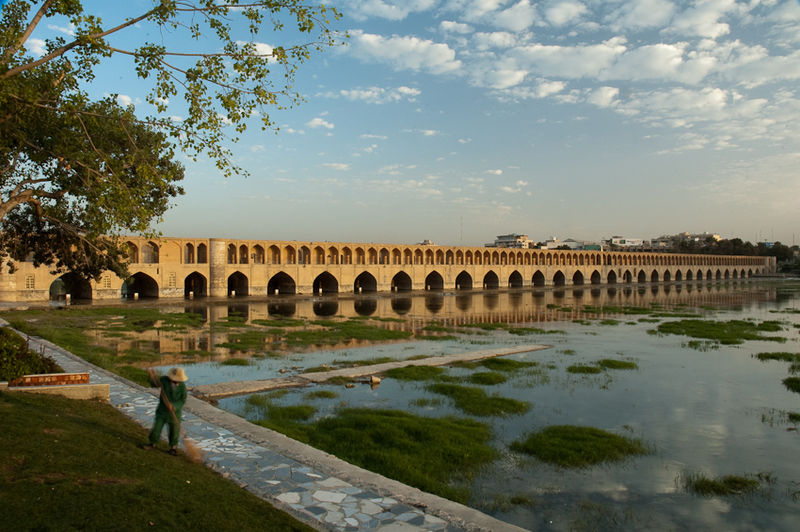Siosepol bridge also known as 33 Bridge, as it is made of 33 arches, is one of the main tourist attractions of Isfahan, Iran. This historical bridge of Isfahan is also called the Allah-Verdi Khan Bridge, named after the provincial governor who oversaw its construction . This bridge is on the Zayanderood River, one of the largest rivers in the center of the country, about 41,500 square kilometers long which flows from the east to the west. In different seasons the view of the river from the bridge is quite spectacular. Siosepol is the first bridge among the eleven bridges built in Isfahan and its construction dates back to 1602. The bridge is about 300 meters long, 14 meters wide and it has about 4350 square meters of deck area which has made it the longest bridge over the river. Sheikh Bahayi, the constructor of this stunning bridge, was one of the greatest mathematicians of his time. iran tour
Described as the finest bridge in the province, Siosepol was built by the Persian Safavid king, Shah Abbas, on the foundations of an older bridge to connect the part of the city where Muslims lived to Armenian quarter of Isfahan,i.e it linked the Muslim quarter on the north bank with the Armenian quarter across the Zayanderood River. Functioning as both a bridge and a dam (or a weir), the bridge also served a primary function as a building with a pavilion in the center of the structure inside which Shah Abbas once sat admiring the view. Now, remnants of a stone seat are all that is left of the king’s chair. This masterpiece is the grandeur and beauty of Iranian architecture and was a place where many ceremonies used to be held by the Safavid Royals.
Every year, during Norouz (the traditional Iranian new year holiday) the bridge is decorated with lights and flowers. The lights on the bridge give it a stunning view as every single arch has its own flashes of light to make the site a shining spot which attracts many more visitors at night than during daylight. This structure consists of two rows of 33 arches from either side, originally decorated with artistic tiles and paintings. The bridge has a sidewalk on the top and another one with a ceiling near the water level. The bridge’s double-decker structure is built of yellow brick and limestone, the typical materials used in Isfahan architecture. The lower level rests on piers, separated by 33 arch sluices where the river can flow past. These sluices give the bridge its name, “Siosepol “, which means “the bridge of 33 arches” in Persian. The upper deck in the middle of the bridge is predominantly designed to be used by government leaders.
Served a primary function as a building and a place for public meetings, this bridge contains a tea-house on the lower deck with tables and chairs set up along a narrow passage under the southern end and also on the outside ledge near the shore. Between the tables, flights of stone steps lead to private chambers, where families or groups of friends can enjoy their tea with enough privacy. Located in the center of the city, Siosepol is one of the most crowded and popular places in Isfahan, especially in the evening. It is worth mentioning that going over the bridge by car is impossible, but you can ride a bicycle there when it is not very crowded.
sio se pol bridge
December 12, 2021
0 comment

Comment (0)